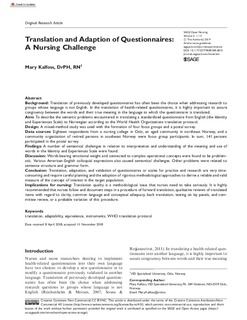| dc.description.abstract | Background: Translation of previously developed questionnaires has often been the choice when addressing research to groups whose language is not English. In the translation of health-related questionnaires, it is highly important to assure congruency between the words and their true meaning in the language to which the questionnaire is translated.
Aim: To describe the semantic problems encountered in translating a standardized questionnaire from English (the Identity and Experiences Scale) to Norwegian according to the World Health Organizations translation protocol.
Design: A mixed-method study was used with the formation of four focus groups and a postal survey.
Data sources: Eighteen respondents from a nursing college in Oslo, an aged community in northeast Norway, and a community organization of retired persons in southeast Norway were focus group participants. In sum, 141 persons participated in the postal survey.
Findings: A number of semantical challenges in relation to interpretation and understanding of the meaning and use of words in the Identity and Experiences Scale were found.
Discussion: Words bearing emotional weight and connected to complex operational concepts were found to be problematic. Various American-English colloquial expressions also caused semantical challenges. Other problems were related to sentence structure and grammar form.
Conclusion: Translation, adaptation, and validation of questionnaires or scales for practice and research are very timeconsuming and require careful planning and the adoption of rigorous methodological approaches to derive a reliable and valid measure of the concept of interest in the target population. Implications for nursing: Translation quality is methodological issue that nurses need to take seriously. It is highly recommended that nurses follow and document steps in a procedure of forward translation, qualitative reviews of translated items with regard to clarity, common language and conceptual adequacy, back translation, testing on lay panels, and committee review, or a probable variation of this procedure | nb_NO |
